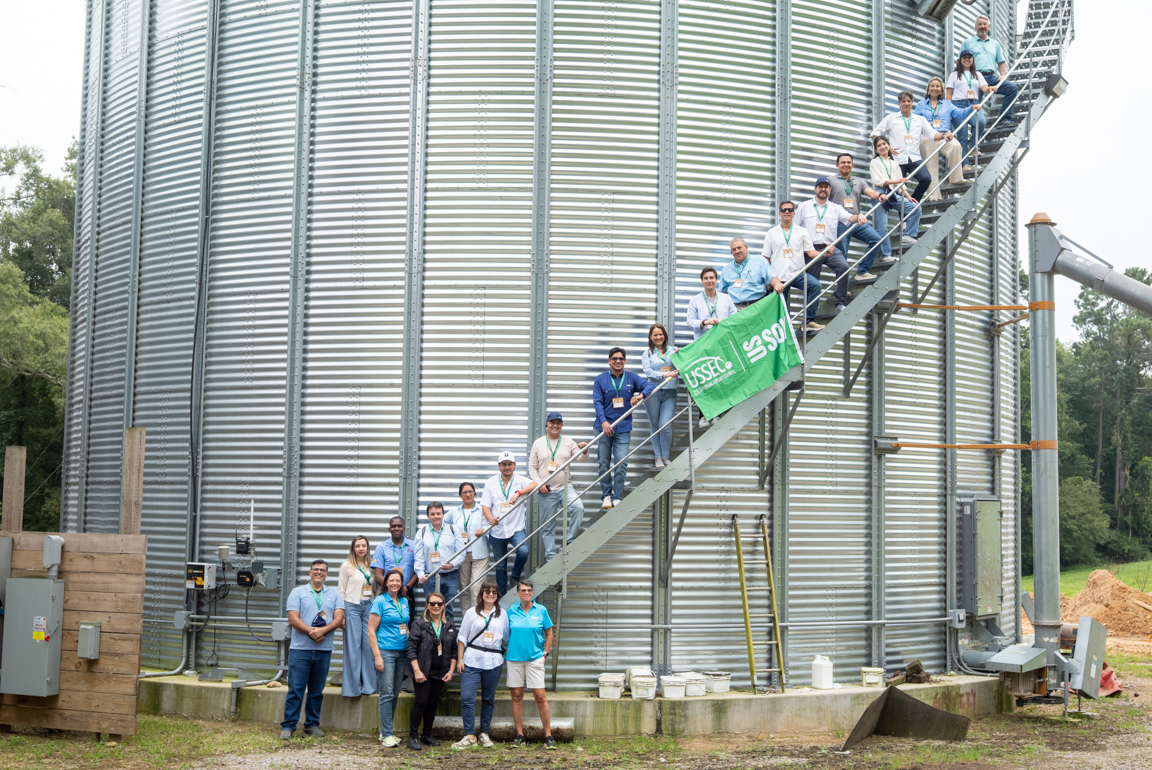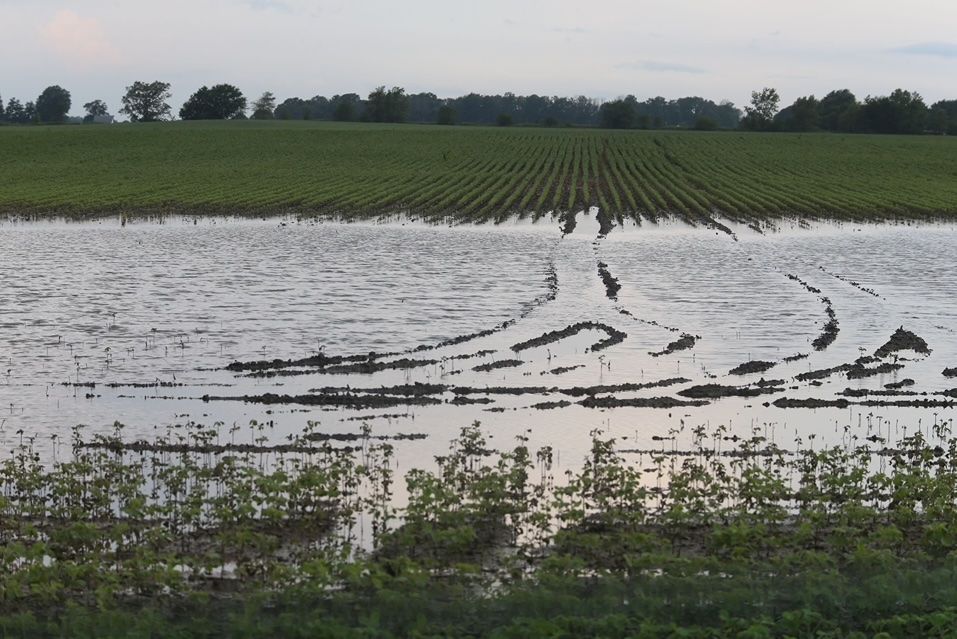Nothing Fishy Here: U.S. Soy Protein Feeds Aquaculture, Grows Demand

Startled by his alarm, Philip Good reached for his phone, half asleep. A flick of his finger across the screen showed him the oxygen levels in his catfish ponds were low. A few taps later and additional aerators were running, stabilizing the oxygen needed for his catfish.
As his smartphone monitors their environment, sustainable U.S. soy provides a nutritious diet for Good’s catfish. It’s one of many ways U.S. soy is the driving factor in producing protein-rich aquaculture in countries around the world.
Good grows 3,300 acres of corn, soybeans and cotton along with catfish in 12 ponds on his fourth-generation farm in Macon, Mississippi.
“We feed a 28% protein feed,” Good says while looking over one of his ponds stocked with thousands of catfish. “The majority of it is soy. We’ve found that is a good fit for feed efficiency in catfish.”
The clay and chalk soils that were naturally deposited in the area provide an ideal environment for the catfish ponds. Good and other farmers in the area started raising catfish to create a new revenue stream in the ’90s.
“We got into it as diversification,” he says. “We are proud of the product. We know about the quality of the meal, the quality of the feed and the quality of the water.”
Aquaculture in the global spotlight
The quality Good and his peers focus on at the farm level adds up to provide a crucial protein source for human diets around the world. Dr. Shakuntala Haraksingh Thilsted, 2021 World Food Prize laureate, pioneered fish-based food systems to improve nutrition, health and livelihoods for millions around the world.
Thilsted was the first to establish that many small fish species commonly eaten across Southeast Asia are an important source of essential micronutrients and fatty acids and improve the absorption of nutrients in plant-based foods, reshaping scientific understanding of the benefits of fish in human diets. This breakthrough has helped prioritize increases in fish consumption and production, transforming the diets of some of the world’s most vulnerable people.
Thilsted’s work has directly impacted outcomes for soy organizations focused on global diets, including the U.S. Soybean Export Council (USSEC) and the World Initiative for Soy in Human Health (WISHH), with support from the soy checkoff.
“Food security is a major issue in the developing and emerging economies where WISHH works. Soy-based feed for aquaculture can be a part of the solution to get more affordable protein to more people,” Liz Hare, executive director of WISHH, says. “It’s exciting to see U.S. soybean growers engage on this issue.”
Soybean meal is an excellent source of protein for the aquaculture and aquafeed industries worldwide. It is an important protein source in the aquaculture diet due to its protein content, balanced amino acid profile and high level of digestibility for most cultured fish and shrimp species. As such, it can replace high-cost animal proteins and yield optimal fish growth. Many aquaculture diets now contain 25%-30% soy as a vital part of the formulation. There are a variety of applications in which soy products can be used in aquaculture diets.
Two organizations with soy leading the way
WISHH and USSEC provide a one-two punch when it comes to marketing U.S. soy around the world. WISHH specializes in developing and emerging markets, where there are currently no U.S. soy exports or very little. The organization also looks at the significance of potential growth. WISHH has made positive impacts in countries such as Tanzania, Nigeria and Cambodia. USSEC specializes in more developed markets, including China, Thailand and Ecuador, and in growing markets such as the Middle East and North Africa.
“The U.S. soy industry has strategically created different trade organizations to focus on markets by development status to ultimately reach our goal of maximizing value for soy exports,” Courtney Knupp, USSEC director of aquaculture and animal nutrition meal, says. “The partnership between USSEC and WISHH is great because we are empowered by soybean farmers to focus on specific markets, enabling each organization to deliver on its mission to ultimately advance and develop all markets with potential for utilizing U.S. soy, including in aquaculture.”
Both WISHH and USSEC see a potential for U.S. soy in an expanding aquaculture industry around the world.
“Aquaculture is a growing industry,” Knupp says. “U.S. soy provides a sustainable and abundant nutritional source of protein to meet the needs of many species in all major regions. That’s a huge benefit for an industry which is predicted to continue rapid growth.”
Approximately 3.3 billion people rely on seafood for almost 20% of their protein intake, making it the world’s largest traded food commodity. The amount of seafood produced by aquaculture now exceeds wild catch. Total fish production is expected to expand from 179 million metric tons in 2018 to 204 MMT in 2030 (source: FAO). Aquaculture consumption increased 122% from 1990 to 2018, and production is projected to reach 109 million tons in 2030 (source: FAO).
“Everything that WISHH does is designed to increase the availability and accessibility of affordable protein,” Hare says. “Most of the countries WISHH works in do not have established aquaculture sectors. We invest a lot of time in aquaculture improvement to increase the amount of protein available through fish.”
Power of the checkoff
The checkoff is a powerful tool used for global marketing, training and information exchange for both organizations.
“I think we are on the threshold of doing with aquaculture what we’ve done with poultry, pork and beef,” Good, who also serves as a soy checkoff farmer-leader, says. “We’ve got the feed, we’ve got the product. It’s sustainable. It’s a tool in the tool belt that we need to introduce to other countries and explain to them what can be done with it.”
Through the use of new technology such as in-pond raceway systems and feed formulation advances, aquaculture continues to provide an important protein source for growing countries.
“U.S. soy optimized feed is part of that picture because it helps with efficiency and it’s a sustainable source for the nutritional requirements of these animals that they feed,” Knupp says. “We can build value change so that every farmer in any market is getting paid the right price and they can manage their feed cost.”
Recently, USSEC’s Global Aquaculture Industry Advisory Council convened with fresh multistakeholder representation from 11 organizations in academia, civil society, industry, public sector and sustainability certification around the world, thereby reaffirming U.S. soy farmers’ and industry’s commitment to shaping a growing and sustainable aquaculture industry.
“Success for U.S. soy is that we see continued growth in aquaculture,” Knupp says. “And that U.S. soy optimized feed is part of that growth because it is the sustainable source for nutritional requirements of fish and seafood worldwide.”



